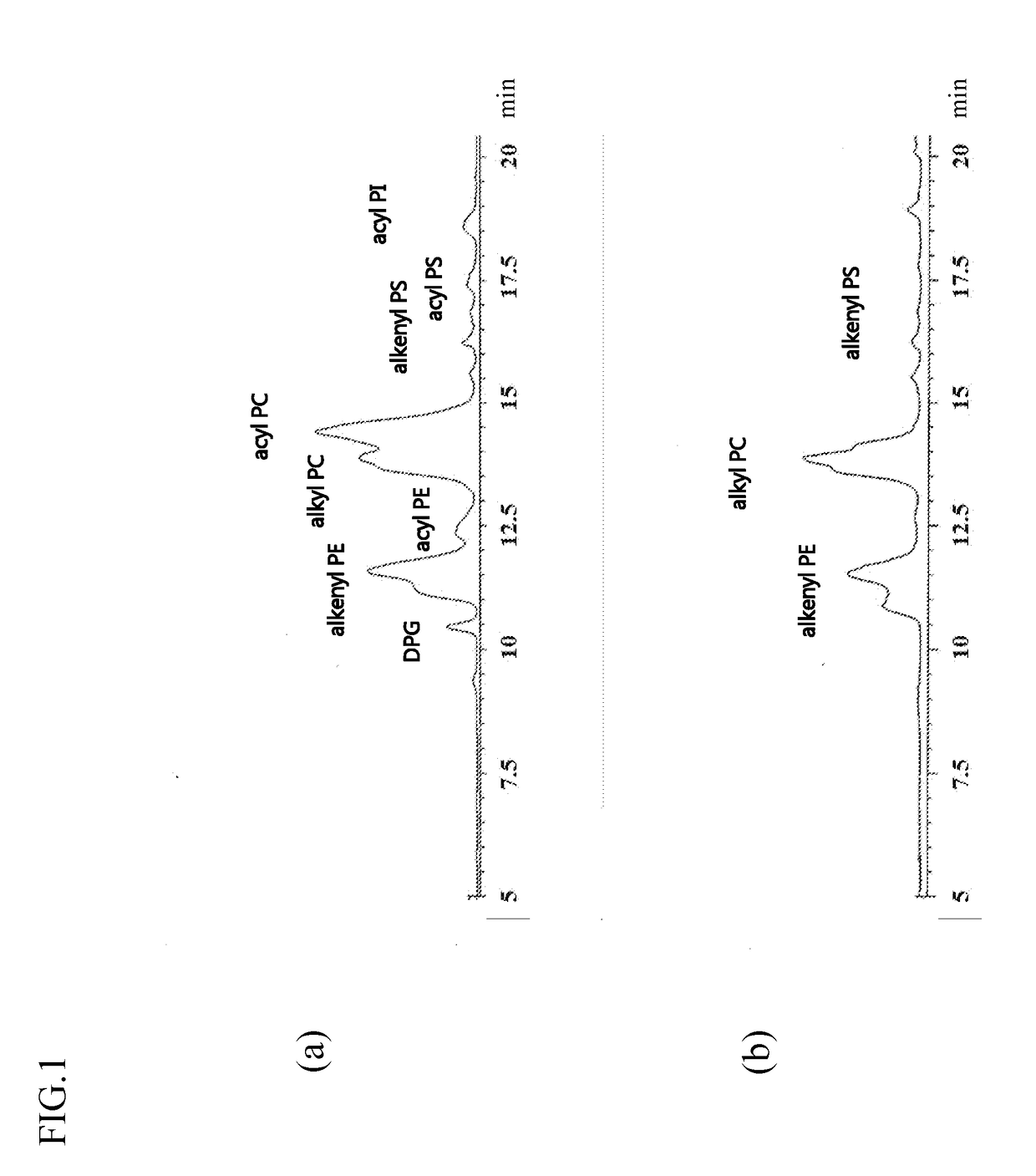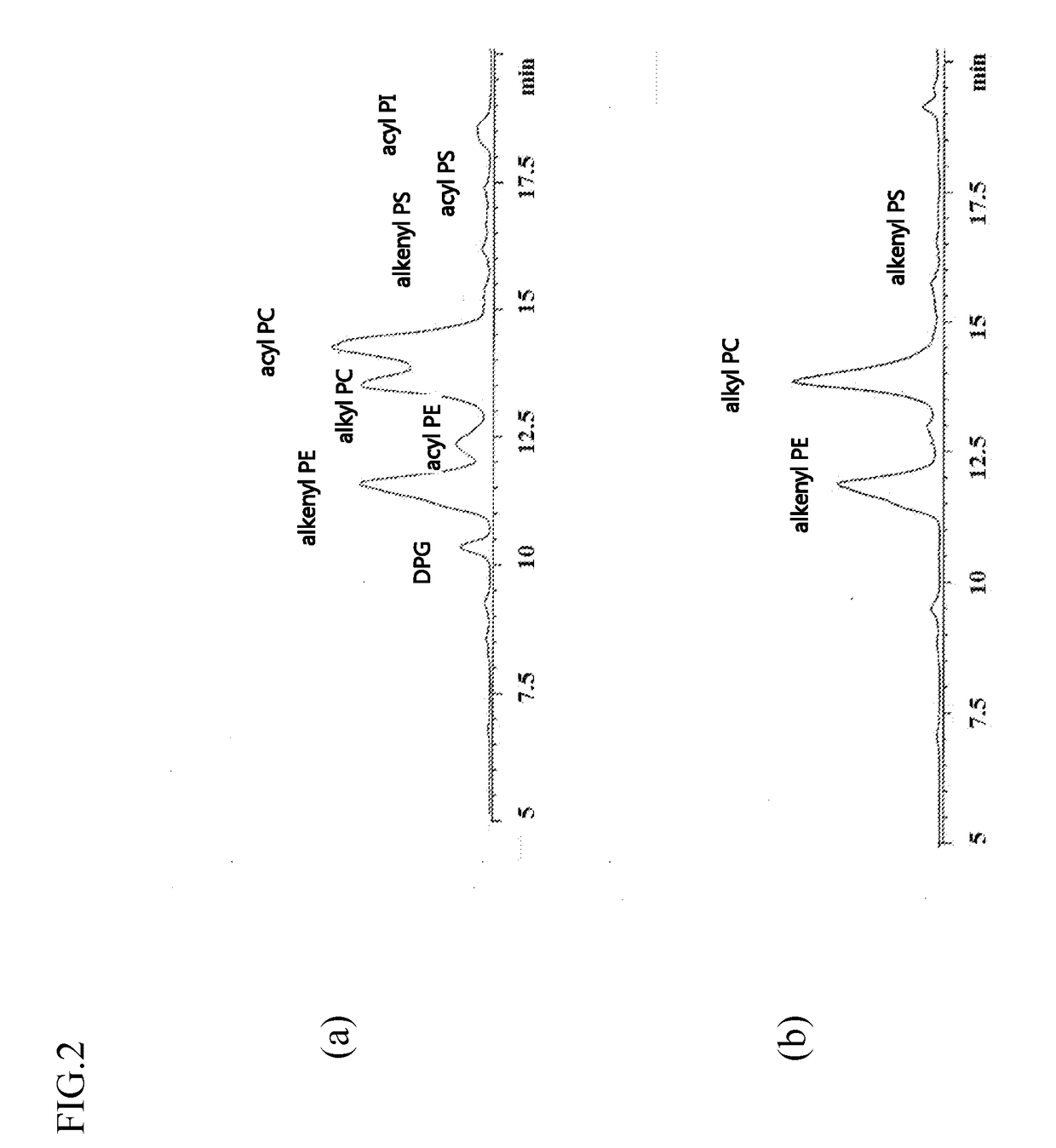Method for producing ether phospholipids
a technology of ether and phospholipids, applied in the direction of fatty-oil/fat refining, fatty-oil/fat separation, group 5/15 element organic compounds, etc., to achieve the effect of easy process
- Summary
- Abstract
- Description
- Claims
- Application Information
AI Technical Summary
Benefits of technology
Problems solved by technology
Method used
Image
Examples
example 1
[0140](Production of Ether Phospholipids Derived from Clams)
[0141](1) Extraction of Total Clam Lipids
[0142]To approximately 200 g of clams after removing shells, 1,000 mL of hexane / isopropanol mixture (3:2) was added, ground by a blender, and placed for 1 hour at a room temperature while mixing.
[0143]Subsequently, suction filtration was provided, and its residue was washed by 200 mL of hexane / isopropanol mixture (3:2) and the filtrate was combined, and then placed in a separating funnel.
[0144]To the separating funnel, 800 mL of water or sodium sulfate aqueous solution (1 g of sodium sulfate was dissolved into 150 mL of water) was added and mixed, then placed in static standing.
[0145]Out of two separate layers, the lower layer was removed, and the upper hexane layer was separated.
[0146]The hexane layer so obtained was dried by a rotary evaporator, and total bivalve lipids were obtained.
[0147](2) Analysis of Clam-Derived Total Phospholipids by HPLC
[0148]HPLC was performed on the total...
example 2
[0177](Production of Ether Phospholipids Derived from Corbiculae)
[0178](1) Extraction of Extraction of Total Corbicula Phospholipids
[0179]Except that corbicula was used instead of clam, total phospholipids were obtained by the method similar to EXAMPLE 1.
[0180](2) HPLC Analysis of Corbicula-Derived Total Phospholipids
[0181]HPLC analysis was provided on the total phospholipids so obtained under the conditions similar to EXAMPLE 1.
[0182]The result is shown in FIG. 2(a).
[0183](3) Purification of Ether Phospholipids by Enzyme Treatment and Extraction Processing of Total Phospholipids
[0184]By using the similar method of EXAMPLE 1, the ether phospholipids are purified by preparing corbicula-derived ether phospholipids from total lipids (purity: approximately 90%).
[0185](4) HPLC Analysis of Purified Corbicula-Derived Ether Phospholipids
[0186]HPLC analysis was provided on the corbicula-derived ether phospholipids so obtained under the conditions similar to EXAMPLE 1.
[0187]The result is show...
example 3
[0190](Production of Ether Phospholipids Derived from Chicken Breast)
[0191](1) Extraction of Extraction of Total Chicken Breast Phospholipids
[0192]Except that chicken breast was used instead of clam, total phospholipids were obtained by the method similar to EXAMPLE 1.
[0193](2) HPLC Analysis of Chicken Breast-Derived Total Phospholipids
[0194]HPLC analysis was provided on the total phospholipids so obtained under the conditions similar to EXAMPLE 1.
[0195]The result is shown in FIG. 3(a).
[0196]In this figure, references are as below:
[0197]ePE: Ethanolamine ether phospholipid
[0198]ePC: Choline ether phospholipid
[0199](3) Purification of Ether Phospholipids by Enzyme Treatment and Extraction Processing of Total Phospholipids
[0200]By using the similar method of EXAMPLE 1, the ether phospholipids are purified by preparing chicken breast-derived ether phospholipids from total lipids (purity: approximately 92%).
[0201](4) HPLC Analysis of Purified Chicken Breast-Derived Ether Phospholipids
[0...
PUM
 Login to View More
Login to View More Abstract
Description
Claims
Application Information
 Login to View More
Login to View More - R&D
- Intellectual Property
- Life Sciences
- Materials
- Tech Scout
- Unparalleled Data Quality
- Higher Quality Content
- 60% Fewer Hallucinations
Browse by: Latest US Patents, China's latest patents, Technical Efficacy Thesaurus, Application Domain, Technology Topic, Popular Technical Reports.
© 2025 PatSnap. All rights reserved.Legal|Privacy policy|Modern Slavery Act Transparency Statement|Sitemap|About US| Contact US: help@patsnap.com



